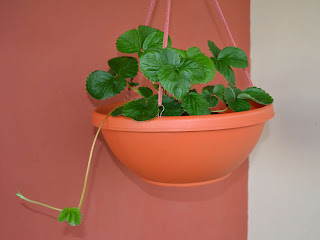 |
| Strawberry. Success!!! |
If you follow us on Twitter (Shameless plug alert: Follow us
@ContnrGardenPR) you know that we're very excited about our strawberry plant. Just thinking of being able to taste fresh strawberries makes us salivate. However, our excitement was subdued by the fact that strawberries are difficult to grow in the tropics (see
The Holy Grail post). They are prone to fungus and root rot due to the high humidity of Puerto Rico. To avoid this make sure your plants are in a well-ventilated area and that during watering no water falls on the leaves. Strawberries may also be victim to the dreaded aphids (We don't have a solution for this one yet but we're working on one.)
Against all odds, and much to our delight, in December our little plant produced a few flowers. Excitedly (and a little compulsively), we observed each day (did I say we were compulsive) how one of the flowers started to become a green strawberry fruit. We cared for it by keeping the soil moist and providing a balanced fertilizer every week.
The time had come. After a few weeks it ripened to a bright red color. We carefully cut the fruit from the plant, washed it clean, and cut it in half (Jessy and I both wanted to taste it). Taste-wise our strawberry tastes slightly less sweet than a supermarket bought fruit. I was expecting a bitter aftertaste but I was pleasantly surprised that it had the flavor I'm used to. In terms of size a supermarket fruit dwarfs our little strawberry which was to be expected. And now we wanted more.
 |
| Mother plant sending out a stolon. |
One of the nice things about growing your own strawberries (besides that sweet fresh flavor) is that they're easy to propagate. The plants you buy at the nursery are called mother plants. They send out runners called
stolons which produce multiple daughter plants. Daughters can be potted and allowed to root (or they could be removed to allow the mother plant to concentrate on fruit production). Keep the potting soil moist and they should develop roots in a few weeks. Once they are fully established you can cut the connection to the mother plant (much as you cut the umbilical cord from a newborn). Voila! You have a brand new plant. With this simple technique you are able to multiply your plants almost infinitely since each daughter plant will become a mother plant after one growing season. As always remember to #spreadthelove by gifting plants to your friends and neighbors. Finally, let us know in the comments section if you've had experience (and hopefully success) in growing strawberries in the tropics.
